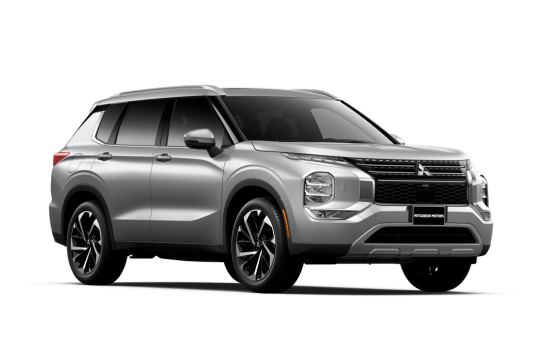
Mitsubishi Outlander LS 2007 review
- Mitsubishi Outlander
- Mitsubishi Outlander 2007
- Mitsubishi Outlander Reviews
- Mitsubishi Reviews
- Mitsubishi SUV Range
- SUV
- Mitsubishi
- Family Cars
- Off road
- 7 seater

As a result, we came to this roadtest with great expectations. We were anticipating a vehicle that had taken a step forward to stand alongside the best in class, if not surpass them, and to be writing about it in glowing terms as a "saviour for the struggling Mitsubishi".
Sadly, it is not. Despite some excellent design and engineering work, and the inclusion of dual front airbags, ABS brakes, air-conditioning, cruise control and a trip computer as standard, we were struck by the cost-cutting evident in the base model Outlander LS tested here.
For starters, there seems to a serious lack of sound-deadening material across the vehicle given the amount of noise that reverberates through the cabin across all but billiard-table surfaces.

Explore the 2007 Mitsubishi Outlander range
The Yokohama Geolandar tyres roar across bitumen sealed with coarse stones and there is a din from within the wheel arches and underneath the vehicle when loose sand and gravel are on the road. Chopped-up surfaces can send unwanted noise and vibration into the cabin, and the new 2.4-litre engine and continuously variable transmission (CVT) combination, too, becomes a source of irritation with the noise created from around 4000rpm.
The LS has lightweight, tinny, resonating doors. The cabin is cheaply finished, using an inordinate amount of hard and easily scratched plastic trim, and exposing bare metal with some shortfalls in floor coverings. A hole in the passenger's footwell trim on our test car left wiring exposed, and the removable section of cargo floor failed to fit properly.
The front suspension also produced a loud, disconcerting knock at the first tight downhill corner, and did so on two other occasions during our test.
So, for all the improvements made with the Outlander's design, packaging and performance, issues arose that detracted from the experience.
The steering rack can produce some rattle, and the steering wheel will writhe in the driver's hands when the vehicle travels through rough corners. When accelerating on loose and uneven surfaces (in 2WD mode), the tiller will also tug with the telltale signs of torque-steer.
This is not as bad as it all sounds, for to some extent it reflects the sports orientation of this small sports utility. Indeed, the Outlander remains one of the most dynamically competent in its class.
Despite being longer, wider and taller than the previous ZF series, Mitsubishi claims this new ZG model — which is based on an all-new platform developed (in a defunct technical alliance) with DaimlerChrysler — is stiffer, stronger, around 20kg lighter, has a wider track, a lower centre of gravity and a revised front strut/rear multi-link suspension.
Those 215/70 R16 Yokohamas offer reassuring grip levels, the body control is excellent, the steering is accurate, braking performance is strong from the 292mm-diameter front disc and 300mm rear "drum in disc" brakes, and the upgraded four-channel, four-sensor ABS bites vigorously into loose dirt surfaces.
The turning circle has shrunk from 11.4m to a far-better 10.6m, and, while the ride is firm, compliance levels are acceptable across a range of road surfaces.
On gravel, the Outlander behaves with more confidence and composure in automatic 4WD rather than 2WD mode and this change can be made on the run, using a large and tactile dial on the centre console. Under auto 4WD, an electronically controlled coupling enables up to 60 per cent of torque to be delivered to the rear wheels.
All this occurs in a seamless fashion, while drive can also be "locked" in a 50:50 front/rear torque split which can be beneficial in tougher, lower speed off-road conditions. Although not really designed for situations such as these — the owner's manual, for example, warns against "driving on steep slopes" — we found the Outlander could make good progress along forest trails.
It does not have low-range gearing and the like, however it does offer decent traction on uphill climbs and useful (210mm) ground clearance.
Engine performance has also improved on the Outlander, which now uses an all-alloy 2.4-litre DOHC four-cylinder unit derived from a three-way alliance with DaimlerChrysler and Hyundai. Featuring "Mivec" variable valve timing on both intake and exhaust valves, the engine produces 125kW at 6000rpm and 226Nm at 4100rpm.
These are minor increases in output over the previous engine, however the combination with a CVT (which has a sequential-manual shift mode) makes for a very different driving experience. With the vehicle unladen, acceleration from standstill is smooth and swift, and at higher speeds and low revs it provides an immediate and energetic burst of pulling power whenever the driver steps on the "loud" pedal.
The trouble is, while CVTs can sometimes be noisier under acceleration than conventional automatics (by virtue of constantly rising in revs), this one is excessive. And while it should be more fuel-efficient than a regular auto, the Outlander returned a disappointing 14.3 litres per 100km over our test.
That is a substantial increase over the sub-10l/100km figure Mitsubishi quotes, and reflects the fact that in real-world conditions the engine is often working hard in the medium-to-high end of the rev range as the driver extracts the desired level of performance. A manual gearbox is expected later in 2007.
Inside, Mitsubishi has relocated the gearshift from the dash to the centre console, and the park brake has also changed from being foot-operated to a conventional handbrake.
The driving position is typically upright and compromised a little with the absence of steering reach adjustment. The seats feel cheaply upholstered, have no lumbar adjustment and could do with more bolstering under the ribcage and thighs, although outright comfort is acceptable over long-distance tours.
The steering wheel spokes have stereo and cruise switches, the centre dash stack controls are well placed and simple to operate, and the instruments are easy to read at a glance. The main problem is the absence of a conventional coolant temperature gauge, which forces the driver to scroll through the trip computer to check its status. Storage and accessory power needs are well catered for.
There is lots of room in all directions across the back seat of the five-seat Outlander. The seat can slide fore and aft, and amenities include door bottle holders, a pull-down centre armrest (with cup holders) and a front seatback map pocket. Air vents or a power socket are nowhere to be seen, though, and dust sticks like glitter-glue on all the dark plastic. Side and curtain airbags are available for $1500.
Adults will appreciate the high rear seatback and adjustable head restraints, parents will welcome the seatbelt locking mechanisms and convenient child restraint anchor point placement, and children will be fascinated — and their carers possibly horrified — by the electric seat-fold mechanism which, with the touch of a button, slams a section of the 60/40 seatback down onto its cushion and then tumbles forward in a fast, almost violent, manner.
This "feature" will not operate unless a rear door or the tailgate is open, but there is no occupant or impediment sensor to avert a nasty accident (we tested it using a kid's toy, which got pulverised). Returning the heavy seats back to their original position is also a cumbersome job.
Without the "occasional use" third row installed, which is a $2800 option, there is plenty of luggage space — a volume of about 1000 litres with the rear seat up and 2000 litres when down. A retractable blind, tie-down hooks, a power socket and small-item storage areas are all provided, however a temporary spare wheel is located under the vehicle.
Rather than hang a full-size spare on the tailgate, Mitsubishi has developed a twin-section tailgate comprising a conventional hatch and a lower fold-out ledge that creates a low, flat loading (and sitting) area.
Design features like this leave a positive impressive with the new Outlander. The question is, can Mitsubishi build more quality into the vehicle while hanging on to its current level of pricing and equipment?
Pricing guides
Range and Specs
| Vehicle | Specs | Price* | |
|---|---|---|---|
| LS | 2.4L, ULP, CVT AUTO | $5,940 – 8,360 | 2007 Mitsubishi Outlander 2007 LS Pricing and Specs |
| VR | 3.0L, ULP, 6 SP AUTO | $5,060 – 7,480 | 2007 Mitsubishi Outlander 2007 VR Pricing and Specs |
| VR-X | 3.0L, ULP, 6 SP AUTO | $6,930 – 9,790 | 2007 Mitsubishi Outlander 2007 VR-X Pricing and Specs |
| XLS | 2.4L, ULP, CVT AUTO | $4,950 – 7,260 | 2007 Mitsubishi Outlander 2007 XLS Pricing and Specs |
$5,950
Lowest price, based on 32 car listings in the last 6 months







